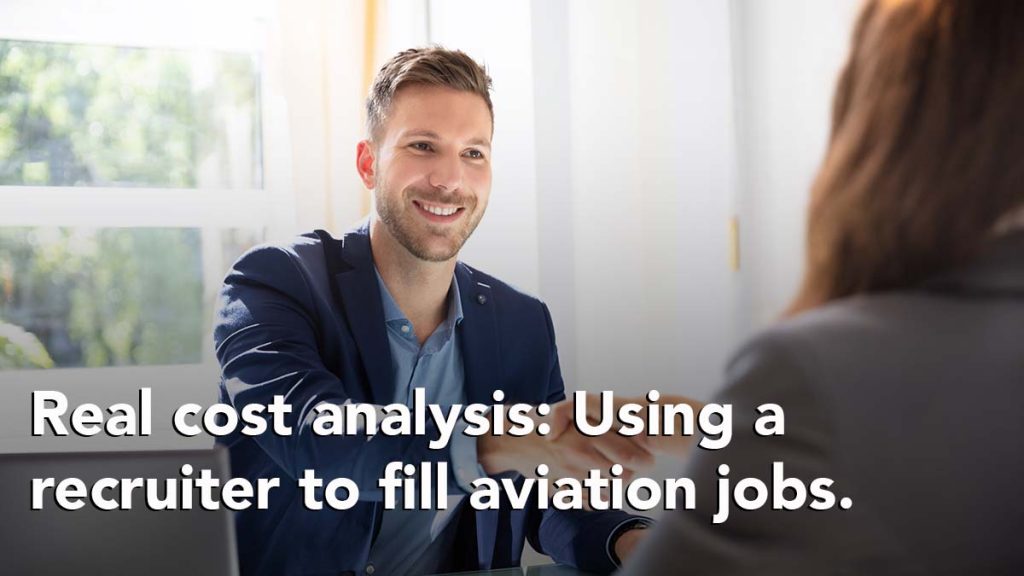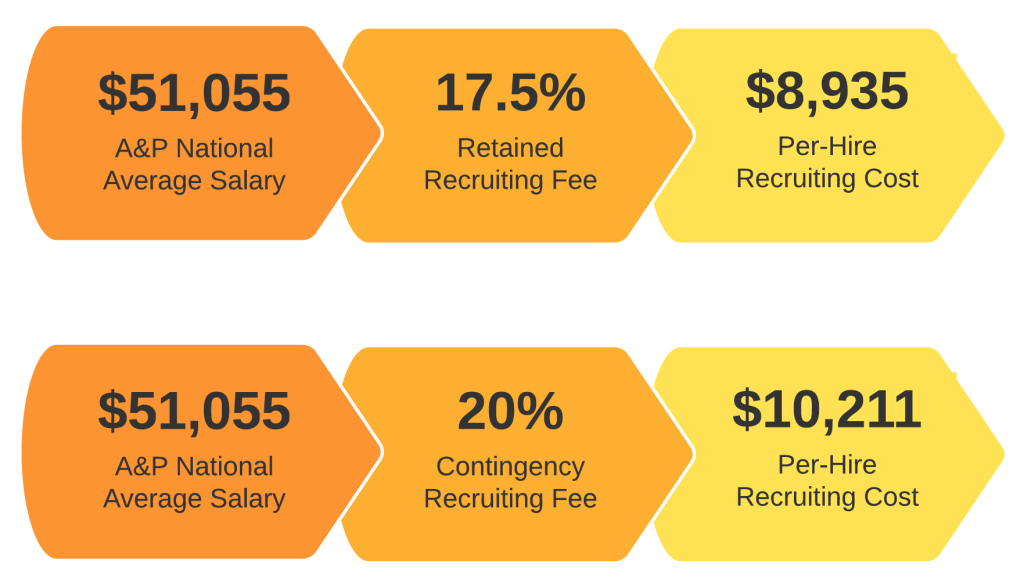
Are you having difficulties finding A&Ps, AMTs, and aviation professionals? Join the club!
It has gotten extremely difficult to find not just the people you need, but the people that fit your open job and organization. Many companies and hiring managers are turning to recruiters to help uncover the hidden gems in the talent pool.
But, with everything, the cost is a factor. An organization must weigh the expense of contracting a recruiter versus the direct and indirect costs of recruiting in-house. Lost revenue and the strain on the workforce of having an empty position are added factors in the equation.
What does a recruiter “really” cost?
Recruiters talk about contingency and retained recruiting options. But what are the real costs for each? Let’s look at an example to explore what contracting a recruiter would cost in a typical situation.
External recruiters cost a bit more per role but perform more extensive searches.
The fee charged by a contract recruiter depends on the recruiting arrangement. It is normally calculated as a percentage of the hire’s first-year compensation. We will use the following recruiting rates for our analysis:
| Contingency Recruiting | 20% first-year compensation |
| Retained Recruiting | 17.5% first-year compensation |
In addition to standard recruiting fees, Fovea Aero can offer reduced or fixed rates for multiple hires. For example, we can offer a fixed, per-hire recruiting cost for a particular role like an A&P, avionics technician, or pilot. This can reduce variability and help you precisely calculate a budget to fill a group of open jobs.
Example A&P per-hire recruiting fee.
Let’s assume you want to fill an A&P position. We can see from our study of national salary information that the average hourly wage for an aviation maintenance professional is $24.55 per hour. This equates to $51,055 a year.
Using the national average yearly compensation for an A&P, the real-world estimated fee for recruiting an A&P hire is:

Contingency recruiting fees are only due if a candidate provided by the recruiter is selected and hired. Otherwise, there is no charge for the suggested candidates.
Retained recruiting fees are paid half up-front and half on the selected candidate’s hire date. Not only does retained recruiting often provide you a discount, but the recruiter prioritizes your openings over others. You are committed to filling the role — something that is not always the case with employers who are simply exploring the talent market without the intention to hire.
Costs using in-house HR and department managers for recruiting.
Some companies choose to utilize HR staff or department managers to perform recruiting and hiring duties. The arduous process of finding, recruiting, communicating with, and screening talent takes a tremendous amount of time. Not only does this take staff away from their primary duties, but it often results in subpar talent searches. This has a definitive cost both in productivity and long-term talent retention.
Finding talent, especially in today’s market, takes a lot of work. Let’s assume that it takes eight weeks to find and hire a new A&P or AMT. During those two months, a hiring manager may spend a significant amount of time engaged in various hiring tasks.
Recruiting and hiring tasks often include:
• Reviewing job postings
• Evaluating resumes
• Communicating with candidates
• Scheduling interviews
• Performing screenings
• Conducting interviews
• Assessing interview results
• Preparing offers
• Negotiating with candidates
• Preparing backup candidates
• Finalizing hiring
• Onboarding
Using department managers for recruiting creates lost productivity and direct costs.
The median salary for an aviation maintenance manager in the United States is $122,103 according to salary.com. We must also add taxes, benefits, and other incidental costs, to the manager’s salary. The rule of thumb is to multiply the employee’s salary by 1.25 to 1.4. We will split the difference and use 1.325. This equates to a total employee cost of $161,786 per year.
Let’s assume that recruiting takes the manager away from their primary duties for 60 hours over the course of a hiring cycle. We are using a number that is less than 10 hours a week, but it is still time away from their primary tasks. Not even considering the ripple effects on the manager’s team, that amounts to $4,677 of the hiring manager’s time lost directly to finding a hire — assuming they can.

That may be on the low end. It often takes more time and effort to find a viable candidate than is initially expected.
Department managers can’t search as aggressively as recruiters.
While the direct cost is understandably lower than contracting a dedicated recruiter, the search performed by a manager is often much less extensive than a recruiter would perform.
Is your hiring manager reaching passive candidates who have not applied for a job? Are they calling your competitor’s talent to see if they want to move?
Recruiters will search their extensive contact databases, social media outlets, professional websites, and others, to identify and reach out to the best candidates for the role rather than waiting for — often subpar — candidates to come to them. Hiring managers simply do not have the time to perform these daily tasks with the amount of work on their plates.
Recruiters offer additional guarantees and benefits.
Many recruiters, including Fovea Aero, offer additional guarantees and benefits. For example, Fovea Aero offers both a free-replacement guarantee and a money-back guarantee on hired candidates. Our only goal is to establish sincere trust and a long-term relationship with our clients. The best way to do that is to bring you the best candidates and stand behind our work. Contact Fovea Aero anytime to learn more about our recruiting guarantee.
Specialized recruiters know the nuances of a job.
Specialized aviation recruiters have technical knowledge of both the industry and specific aviation roles. This may exceed what HR professionals are required to know when recruiting for a role. HR professionals are great at their jobs, but may not have the bandwidth or time to dive into the technical details needed to separate candidates that appear similar on the surface but may have very different skillsets and experiences.
Contract recruiters know what your competition is doing.
Recruiters will work with many different companies. They see how others are recruiting and hiring for the same roles you are. Where are the best candidates? What are the best ways to reach them? An outside recruiter can bring new ideas and insights to energize stale or stalled recruiting and hiring practices.
They have extensive contacts and talent pools.
Contract recruiters have extensive databases of potential candidates. Unlike department managers and HR professionals, recruiting is all they do — every day! Recruiters can reach into talent pools not available to internal resources. They also have tools and techniques that are often not available or too time-consuming for in-house staff.
Contingency recruiting has little risk.
By definition, there are no fees associated with contingency recruiting unless you hire a candidate the recruiter provided. The recruiter has taken on the risk of finding a great candidate for your role. Either they perform by providing a candidate you want to hire or they don’t get paid.
Choosing a recruiting approach.
Contracting a recruiter comes with a cost. It is up to you to determine if that cost is less than the cost of lost revenue from having an open position, lost productivity from using internal resources for recruiting, lost efficiency from not undertaking a dedicated search and lost options from not aggressively pursuing both active and passive candidates.
Recruiting and hiring talent is one of the biggest concerns for aviation companies in today’s market. Doing it better than your competition and dedicating a specialized resource to it — whether internal or external — can be a key to your success.